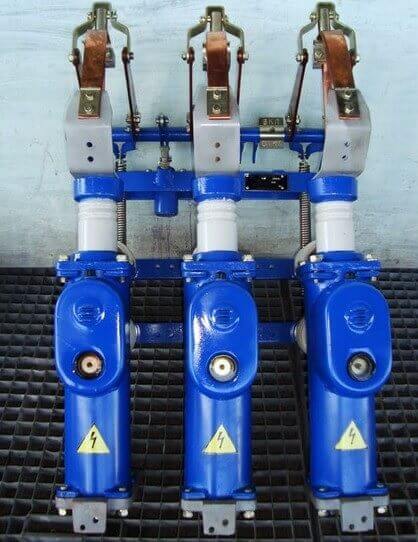What is an interphase short circuit
Where arise and why
Short circuit can occur in all nodes of the electrical installation:
- In consumers, with damage to insulating gaskets and parts of the housing, as well as water ingress.
- In an electric motor. It can occur as a breakdown of insulation of the motor windings to the housing (to the ground). Sometimes they say “the engine burned out”, just like that, it can’t burn out, usually the increased values of the currents flowing through them lead to burnout, and this is caused by an interturn circuit. The resistance of the winding decreases, the current begins to grow, the winding heats up. Because of this, insulation is destroyed. After this, the lesion focus can reach the windings of adjacent phases, an interphase short circuit will occur, and if some of the conductors with damaged insulation touch the case, then this is a short circuit to ground (zero).
- Transformer windings. It happens similarly to electric motors.
- In the ASU, in parts of disconnecting devices, circuit breakers, starters, contactors and other things.
- On high voltage lines.
There are a lot of reasons for the occurrence of interfacial faults, starting from pollution, ingress of metal parts, tools, conductive dust. It follows that the ingress of foreign objects into the control cabinet leads to an interphase fault or to the housing. If it is grounded, then to the ground, and if not grounded, the case will be at dangerous potential. Touching such a cabinet by a person will result in electric shock.
The current strength of the interphase circuit depends on its type and conditions, let's look at them:
- Metallic occurs when two current-carrying parts of opposite phases are connected by a metal object, these can be parts of collapsed metal structures, a metal tool lost in a cable assembly, etc. In this case, an arc does not occur, metal parts begin to be welded to the tires, the current flows extremely large, it is limited by the resistance of the cables, transformer windings and the part crossing them.
- The arc occurs even when there is an air gap between the live parts. It can occur even with careless voltage measurement with a high-voltage indicator or with short-term interfacial interruption. Its current is less than that of metal.
- Smoldering occurs in cable lines, such as contamination of insulators. The flowing current warms up the short-circuit section, there are two development options: either the short-circuit will eliminate itself or will progress as described above.
- In the breakdown of semiconductor elements, such as a diode bridge. The current is very large, as with a metal one.
To limit the interfacial short-circuit current, reactors are used - electrical apparatuses to limit the short-circuit shock current. In fact, this is a coil or inductor, which limits the short-circuit current to its reactance. The characteristics of the line also affect: the longer the line and the smaller its cross section, the less the interfacial fault current.
Consequences of short-circuit and ways to prevent them
Short circuit is characterized by the flow of increased current values. In turn, high current is dangerous for cables, connections. This is characterized by an avalanche-like development of the consequences of a circuit. Cables are fenced off from the connections, the connections themselves are heated, after which their accelerated destruction occurs. Heating may cause electrical fire and fire.
To prevent the effects of interphase faults in the 220/380 circuits fuses, fuses, circuit breakers are used. Fuses, when current above the rated current flows through them, blow out, thereby breaking the circuit. After replacing the fuse, if you have not eliminated the interphase fault, it will blow again and again.
To improve working and operating conditions, eliminate the need to replace fusible elements are used circuit breakers. They respond both to a slight increase in current above the norm (thermal release), and to a sharp strong increase (electromagnetic release). In the event of a phase-to-phase fault or between phase and earth, the circuit breaker will open. In such cases they say "knocked out the machine." To resume the voltage supply, it is necessary to re-cock the automatic machine lever or toggle the button (on the AP-shkah).
The video clearly shows the danger of an interphase short circuit (a mannequin fell under the blow, these were demonstrations):
Interphase circuit of a high voltage line: protection methods
Circuits over 1000 Volts do not use automatic disconnectors, since when switching equipment is switched off under load, a strong arc is formed, for this purpose, for example, oil, vacuum or SF6 circuit breakers are used.
Relay circuits are used to protect high-voltage networks. They are not as complex as they might seem, but they are very logical. A core of a high voltage cable or bus passes through a current transformer, which measures the value of the current through the magnetic field around the conductor. Depending on the magnitude of the flowing current, a small secondary current (usually up to 5 A) appears on the terminals of the current transformer, which is directly proportional to the current strength in the measured circuit. With an interphase circuit, the current increases significantly, after which the relay part of the circuit enters into operation, applying a trip pulse to the drive of the high-voltage circuit breaker, or rather to the winding of an electromagnet that trips the circuit breaker.
In conclusion, I would like to note that a short circuit is an extremely dangerous phenomenon, an arcing can cause a fire, as well as incandescent connectors, so do not neglect protective equipment (fuses and circuit breakers). In the best case, the cables will simply be burned off, if the protection devices did not work, in the worst it will lead to a fire and electric shock to people nearby. We hope that now you know what interfacial circuit is, what are the causes of its occurrence and consequences.
Useful materials:











